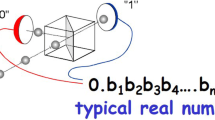Abstract
Curiously overlooked in physics is its dependence on the transmission of numbers. For example, the transmission of numerical clock readings is implicit in the concept of a coordinate system. The transmission of numbers and other logical distinctions is often achieved over a computer-mediated communications network in the face of an unpredictable environment. By unpredictable we mean something stronger than the spread of probabilities over given possible outcomes, namely an opening to unforeseeable possibilities. Unpredictability, until now overlooked in theoretical physics, makes the transmission of numbers interesting. Based on recent proofs within quantum theory that provide a theoretical foundation to unpredictability, here we show how regularities in physics rest on a background of channels over which numbers are transmitted. As is known to engineers of digital communications, numerical transmissions depend on coordination reminiscent of the cycle of throwing and catching by players tossing a ball back and forth. In digital communications, the players are computers, and the required coordination involves unpredictably adjusting “live clocks” that step these computers through phases of a cycle. We show how this phasing, which we call logical synchronization, constrains number-carrying networks, and, if a spacetime manifold in invoked, put “stripes” on spacetime. Via its logically synchronized channels, a network of live clocks serves as a reference against which to locate events. Such a network in any case underpins a coordinate frame, and in some cases the direct use of a network can be tailored to investigate an unpredictable environment. Examples include explorations of gravitational variations near Earth.

Similar content being viewed by others
References
Myers, J.M., Madjid, F.H.: Ambiguity in quantum-theoretical descriptions of experiments. In: Mahdavi, K., Koslover, D. (eds). Advances in Quantum Computation, Contemporary Mathematics Series, vol. 482, pp. 107–123. American Mathematical Society, Providence, I (2009). arXiv:1409.5678
Myers, J.M., Madjid, F.H.: Distinguishing between evidence and its explanations in the steering of atomic clocks. Ann Physik 350, 29–49 (2014). arXiv:1407.8020
Soffel, M., et al.: The IAU resolutions for astrometry, celestial mechanics, and metrology in the relativistic framework: explanatory supplement. Astron. J. 126, 2687–2706 (2003)
Einstein, A.: Zur Elektrodynamik bewegter Körper. Ann Physik 17, 891–921 (1905)
Turing, A.M.: On computable numbers with an application to the Entscheidungsproblem. Proc. Lond. Math. Soc. Ser. 2 42, 230–265 (1936)
Madjid, F.H., Myers, J.M.: Clocking in the Face of Unpredictability Beyond Quantum Uncertainty. arXiv:1504.04345 (2015)
Shannon, C.E.: A mathematical theory of communication. Bell Syst. Tech. J. 27, 379–423, 623–656 (1948)
Madjid, F.H., Myers, J.M.: Matched detectors as definers of force
Myers, J.M., Madjid, F.H.: Rhythms of memory and bits on edge: symbol recognition as a physical phenomenon. arXiv:1106.1639 (2011). Ann Physik 319, 251–273 (2005). arXiv:quant-ph/0404113
Myers, J.M.: Modeling the effect of an external electric field on the velocity of spike propagation in a nerve fiber. Phys. Rev. E 60, 5918–5925 (1999)
Bennett, C.H.: Logical reversibility of computation. IBM J. Res. Dev. 17(6), 525–532 (1973)
Acknowledgments
We dedicate this paper to Howard Brandt, with whom, over decades, we have had the benefit of wide-ranging discussions touching on predictability.
Author information
Authors and Affiliations
Corresponding author
Rights and permissions
About this article
Cite this article
Myers, J.M., Madjid, F.H. Unpredictability and the transmission of numbers. Quantum Inf Process 15, 1057–1067 (2016). https://doi.org/10.1007/s11128-015-1093-y
Received:
Accepted:
Published:
Issue Date:
DOI: https://doi.org/10.1007/s11128-015-1093-y




